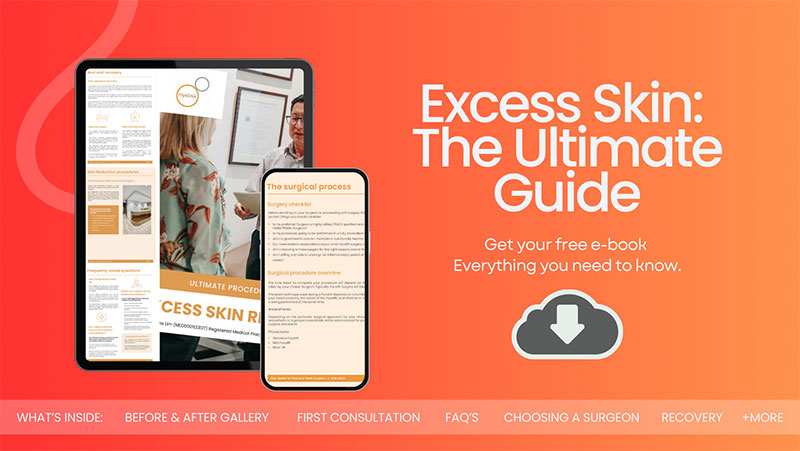Strategies for Reducing Scarring Post Body Lift Surgery
Body lift surgery is a procedure chosen by many to change the shape and tone of their body. Whether you’ve opted for this surgery following significant weight loss or to address excess skin and tissue, the post-operative phase is an essential part of the journey. One of the primary concerns after the body lift surgery is the appearance of scars. This blog provides tips and recommendations on how to minimise scars after body lift surgery. By understanding the body’s healing process and implementing effective care techniques, you can achieve a more refined appearance of scars, allowing you to appreciate the results of your procedure fully.
With a commitment to achieving your desired results, Sydney Specialist Plastic Surgeon Dr Jake Lim is known for his attention to detail and his patient-centred approach.
Dr Lim’s 2024 Excess Skin Guide

What Is Body Lift Surgery?
Body lift surgery is an all-encompassing procedure addressing loose skin and persistent fat deposits in various body regions. Rather than multiplel independent operations, a body lift encompasses several treatments combined, including a possible combination of:
- Liposuction: Targets and removes fat that hasn’t budged with regular diet and exercise. This technique can address fat in any part of the body
- Thigh Lift: Focuses on eliminating surplus skin and enhancing the contour of the upper legs
- Buttock Lift: Aims to refine the appearance, size, and balance of the buttocks
- Abdominoplasty: Concentrates on removing surplus skin, extra fat, and stretch marks from the stomach area. Additionally, it can assist in strengthening split abdominal muscles
- Arm Lift: Designed to diminish the appearance of excess skin folds under the arms and sculpt a more toned upper arm
- Breast Reduction: Works to enhance comfort, alleviate pain, and improve the look of excessively large or ptotic breasts
Understanding Scarring: The Basics
Scarring is a natural part of the body’s healing process. When the skin is injured, whether it’s due to a surgical incision, an accident, or any other form of trauma, the body works diligently to repair the damage. As the wound heals, a scar may form as a result. However, not all scars are the same, and various factors can influence how a scar develops and appears over time.
Types of Scars
- Flat Scars: These are the most common type of scars. They’re generally flat and pale, and while they might initially appear red or raised immediately after the wound has healed, they tend to become less noticeable over time
- Keloid Scars: These scars are the result of an overly aggressive healing process. They extend beyond the original injury and can continue to grow over time. Some people are more genetically predisposed to developing keloid scars
- Hypertrophic Scars: Similar to keloid scars, hypertrophic scars are raised, but they don’t grow beyond the boundary of the original injury. They may become less raised over time even without treatment
Factors Influencing Scar Formation
- Depth and Size of the Wound: Generally, larger and deeper wounds tend to produce more noticeable scars. Surgical incisions, deep burns, or significant trauma to the skin are more likely to result in pronounced scarring
- Location on the Body: Some areas of the body are more prone to scarring than others. For instance, the chest and back are more likely to produce keloid and hypertrophic scars
- Age: Younger skin tends to heal faster and more efficiently than older skin. However, younger individuals might also be more prone to certain types of scars, like keloids
- Genetics: Your family history can play a role in how you scar. If close family members have a history of keloid or hypertrophic scarring, you might be at a higher risk
- Skin Colour: People with darker skin tones might be more susceptible to keloid and hypertrophic scars. However, they’re less likely to experience red or discoloured scars that can sometimes occur in lighter skin tones. Some patients however, may experience pigmented scars
- Wound Care: How a wound is cared for can significantly influence the scarring process. Keeping a wound clean, moist, and protected can reduce the risk of prominent scarring
Top Methods to Reduce Scarring Post-Surgery
After undergoing body lift surgery, it’s natural to be concerned about the appearance of scars. While some scarring is inevitable, there are several methods you can employ to ensure they heal as discreetly as possible. Let’s explore some of the top methods to reduce scarring post-surgery.
Immediate Aftercare
The initial days following your surgery are essential in determining how your scars will develop.
- Keeping the wound clean is paramount. Dr Lim will instruct you to leave the dressings intact until your first post-op appointment
- Gently wash the area with mild soap and water as advised by your plastic surgeon
- Pat the area dry with a soft cloth, being careful not to rub or irritate the wound
- It’s essential to give your body the rest it needs
- Activities that put strain on the incision site can interfere with the healing process
- Follow Dr Lim’s advice on when it’s safe to resume regular activities
Proper Wound Dressing
- Dressings protect the wound from bacteria and reduce the risk of infection
- They also keep the area moist, which can prevent the formation of a hard scab and promote better healing
- Always use the type of dressing recommended by Dr Lim and only change it as directed
Massage Techniques
- Massaging can improve blood circulation to the area and promote healing
- It can also help in breaking down scar tissue, making scars softer and less noticeable
- Always wait until the wound has fully healed before starting any massage
- Use a non-perfumed lotion or oil and apply gentle pressure in a circular motion
Topical Treatments
- There are various creams, gels, and ointments available that can aid in scar reduction
- Silicone gel sheets can help keep the scar hydrated and may reduce its appearance
- Vitamin E oil is known for its skin-healing properties and can be applied to the scar once the wound has closed
- Always do a patch test before applying any new product to a large area
Sun Protection
- Sun exposure can darken the scar, making it more noticeable
- Protecting the scar from the sun is essential, especially in the early stages of healing
- Wear clothing that covers the scar when possible
- If the scar is exposed, apply sunscreen with high SPF and reapply regularly if you’re outdoors for extended periods
Professional Scar Treatments
When addressing scars, especially those that are particularly noticeable or raised, many individuals turn to advanced treatments. While at-home, care plays a pivotal role in scar management, there are instances where more professional interventions might be sought. Among these treatments, steroid injections and laser therapy stand out as popular choices.
Steroid Injections
Steroid injections are frequently used to treat raised scars, such as keloids and hypertrophic scars. The primary aim of these injections is to flatten the scar, aligning it more with the surrounding skin. By introducing steroids, inflammation is reduced, which in turn can decrease the size and appearance of the scar. During the procedure, Dr Jake Lim will inject a steroid solution directly into the scar tissue. Depending on the scar’s size and severity, multiple injections might be required over time. While this method can significantly reduce the height and redness of raised scars, it’s essential to be aware of potential side effects. Some individuals might experience skin discolouration at the injection site. As always, discussing potential risks and benefits with your plastic surgeon is essential.
Laser Therapy
Laser therapy has gained traction in recent years as a sought-after method to treat a variety of scars. The procedure involves using focused light energy to improve the appearance of scar tissue. Different lasers can be employed to target specific aspects of the scar, such as its colour or texture. During the treatment, a trained professional will use a handheld laser device on the scarred area. Depending on the desired results and the scar’s characteristics, multiple sessions might be necessary. The benefits of laser therapy are notable. It can enhance the colour, texture, and overall appearance of scars, offering a non-invasive option with minimal recovery time. However, post-procedure, some individuals might experience redness or swelling, which typically subsides within a few days. Before opting for laser therapy, it’s vital to consult with a professional to ensure it’s the right fit for your specific scar and skin type.
When to Seek Professional Help
While many aspects of recovery are expected, certain signs may indicate a need for professional intervention:
Signs of Infection
Infection can hinder the healing process and potentially lead to more pronounced scarring. It’s vital to be aware of the following symptoms:
- Increased Pain: While some discomfort is expected after surgery, a sudden increase in pain or pain that doesn’t improve with time might indicate an infection
- Swelling: Some swelling is normal, but if it becomes excessive or doesn’t subside, it’s a cause for concern
- Foul Odour: Any unpleasant smell coming from the wound site can be a sign of an infection
- Discharge: While some clear fluid might be present, the appearance of yellowish or greenish pus is a clear sign of infection
- Fever: A raised body temperature can indicate that your body is fighting off an infection
If you notice any of these signs, it’s essential to contact your plastic surgeon or healthcare provider immediately.
Abnormal Scar Growth
While scars will naturally change in appearance as they heal, certain growth patterns might indicate a problem:
- Raised Scars: If a scar becomes raised above the skin level and continues to grow, it might be a keloid or hypertrophic scar
- Spreading Scars: Scars that grow beyond the original wound boundaries need attention
- Thickening: A scar that becomes excessively thick or hard might require intervention
FAQs about Minimising Scars after Body Lift Surgery

How long will it take for my scars to fade after body lift surgery?
- Scars go through various stages of healing. Initially, they might appear red and raised, but over time, often 12 to 18 months, they can become paler and flatter. However, the exact duration varies from person to person and depends on factors like skin type, age, and the specific surgical procedure.
Are there any specific products I should use to minimise scarring?
- Yes, there are several products designed to aid in scar healing. Silicone gel sheets, vitamin E oil, and certain scar-reducing creams can be beneficial. It’s essential to consult with Dr Lim before starting any topical treatments to ensure they’re suitable for your skin and the stage of healing you’re in.
Can I exercise after my Body lift surgery?
- While exercise is beneficial for overall health, it’s crucial to avoid strenuous activities immediately after surgery. Engaging in vigorous activities can strain the incision site and potentially worsen scarring. Always follow Dr Lim’s advice on when it’s safe to resume exercise and start with low-impact activities.
Will sun exposure affect my scars?
- Yes, sun exposure can darken scars, making them more noticeable. It’s recommended to protect scars from direct sunlight, especially in the early stages of healing. If the scar is exposed, use sunscreen with high SPF and reapply regularly.
What if my scar becomes raised or itchy?
- Some itchiness is normal during the healing process. However, if you notice your scar becoming excessively raised, itchy, or if it grows beyond the original wound (keloid), it’s essential to consult with Dr Lim. He can provide treatments or interventions to address these concerns.
Further Reading about Minimising Scars after Body Lift Surgery
- Read Dr Lim’s Blog about Will Medicare Cover My Tummy Tuck – Abdominoplasty Surgery?
- Read Dr Lim’s Body Contouring After Weight Loss
- Read Dr Lim’s Blog about 5 Methods to Reduce Your Abdominoplasty Scars
- Read Dr Lim’s Blog about How Do the Scars Look Like after Abdominoplasty
- Read Dr Lim’s Abdominoplasty (Tummy Tuck) Surgery Page
- Read Dr Lim’s Blog about Body Lift Procedure in Stages
- Read Dr Lim’s Blog about What is 360 Body Lift Surgery?
- Read Dr Jake Lim’s Blog about Benefits of Silicone Tape after Plastic Surgery
- Read Dr Jake Lim’s Blog about How to Reduce Bruising and Swelling after Body Lift – Truncoplasty Surgery
Medical References about Minimising Scars after Body Lift Surgery
- Medial Thigh Contouring After Massive Weight Loss – NCBI
- Skin removal surgery: Types, recovery, and what to expect – Medical News Today
- Assessment of Laser Effects on Skin Rejuvenation – NCBI
- Scar Treatments: Types of Scars and Their Treatments – WebMD
- Thigh Lift (Thighplasty): Types, Surgery, Recovery & Scars – Cleveland Clinic




